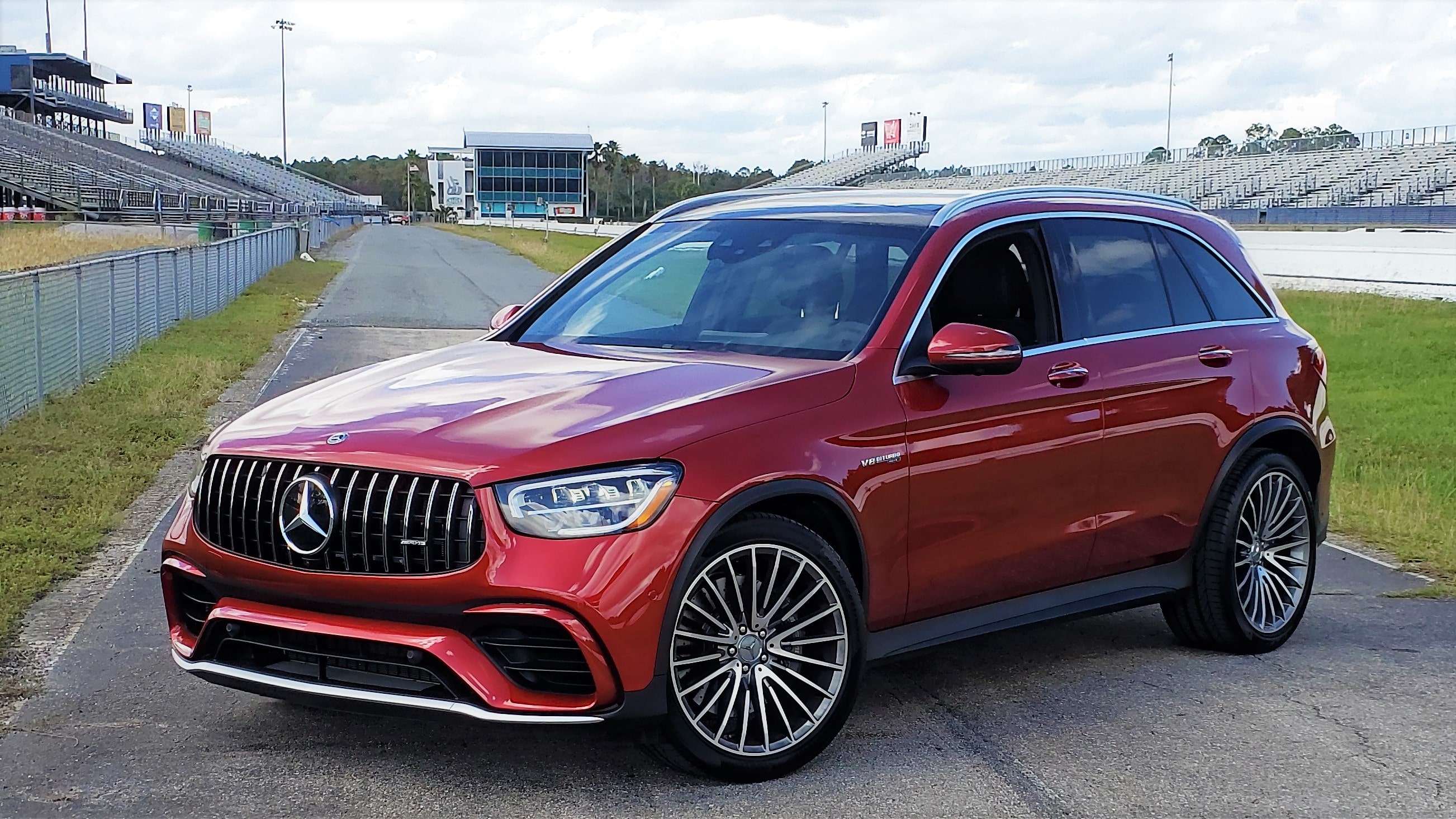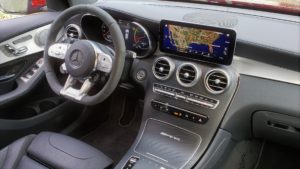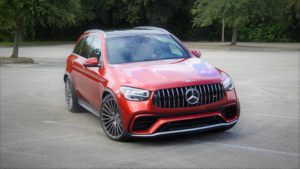
Oh no, not another crossover!
Unless it’s a Mercedes-AMG GLC 63. Its S version lapped the Nürburgring in 7.49.369 minutes, making it the fastest SUV in the world at the time.
Yes, this is a 5-seat, 5-door compact crossover. But with our GLC 63’s twin-turbocharged 469-hp V-8 hand-built by AMG bellowing inside a gorgeous Cardinal Red Metallic paint job and hunkering on grippy 21-inch Pirelli P-ZERO rubber, this is the way I want to take the kids to school.
I’ll even set my own lap record of the local box store’s parking lot.
– The base GLC 300 looks like a crossover – little 18-inch wheels under a rounded boxy shape with turbocharged inline four and 255-hp. Then gaze at our AMG GLC 63, built by the same folks who gave us the E63 AMG S Wagon I tested in May with 603 hp and 60 mph in 4 seconds.
It’s 1.5 inches lower than the base GLC, with a gaping AMG-specific 17-bar grill, big Benz star center-stage. It’s flanked by redesigned LED headlights framed by DRL slashes. Gaping side intakes flare, tapering to a thin centerline over a deep lower intake trimmed with silver and black front splitter. Flared black wheel arches trim each flared fender, framing that rubber on 20-spoke AMG alloy wheels. Their thin spokes allow a neat view of huge perforated disc brakes with gray AMG-badged calipers.
The black lower door sill flares, as “V8 BITURBO 4Matic” fender badges attract attention. There’s bigger, redesigned LED double-block taillights. The sculpted bumper has a black lower fascia with new trapezoidal quad stainless steel tailpipes imprinted with the AMG logo, framing rear diffuser fins.
It is low and aggressive, more muscle car than Daddy hauler.
– A driver-centric cockpit greets you, starting with nicely bolstered leather and suede AMG sport seats with multiple power adjustments and three memory presets for both. The flat-bottom, thick, suede-wrapped steering wheel has big alloy paddle shifters in back, and cruise, phone, voice command and audio buttons in front. It’s power tilt and telescoping, with touchpads that handle the dual-screen MBUX infotainment system added for 2020.
Padded, stitched MB-Tex leatherette and aluminum trim surrounds us, with color accent lighting on doors and console, the latter with grained black ash wood. The driver gets a multi-configurable 12.3-inch digital gauge display with three options. “Classic” and “Sport” mimic a 200-mph analog speedometer and 8,000-rpm tach with configurable information display in the middle for navigation, performance settings, audio, phone and more. “Supersport” goes with a central tach, inset digital speedometer, then basic day/date to keep it simple.
All displays can be selected via the steering wheel’s left touchpad. Then there’s two new controls below the upper spokes. One lets the driver select the exhaust sound, suspension setting, Sport/stability control, auto engine start/stop, and manual paddle shifting. On the right, another small display with thumbwheel to set “Slippery,” “Comfort,” “Sport,” “Sport+” or driver-selectable “Individual” drivetrain and suspension modes. These echo controls on the center console.
The right steering wheel touchpad controls the 10.25-inch touchscreen atop the center dash. There’s a detailed navigation map, with a feature that splits the screen to add the front camera view with arrows showing which road you should turn. It can access the superb Burmester surround sound audio system. There’s Apple CarPlay and Android Auto for your smartphone’s features. That main screen can track apps, adjust climate control, or show a performance page to set drive modes, display instant horsepower and torque, or all-wheel-drive split, G-force and percent throttle and brake. There’s TRACK PACE, to record lap times at racing circuits, show turns, braking points, delta speed and absolute times. It analyzes your laps on race track maps already loaded on it, or those you configure yourself. There’s also a dragstrip theme, with telemetry you can record.
You access all that off the COMAND touchpad (no more knob) in the center console, next to a volume control, surround-view camera, “Home” screen and “return” buttons. Twin cup holders, a USB port and inductive phone charger too small for my larger smartphone hide under a door nearby. Or just say “Hey Mercedes,” and a phrase can access navigation, infotainment and vehicle operation without a hand straying from the wheel. It was almost flawless, handling navigation with a simple “Take me to …” That said, it sometimes activated accidentally if I mentioned “Mercedes” in conversation.
The back seat is roomy for two, with great head and leg room under the rear moonroof. Outboard seats are heated. The rear cargo area is wide, deep and fully carpeted, with controls to drop the 40/20/40 rear seatbacks. There’s storage under the floor, with a key lock. The hatch powers open with a wave of a foot, high enough to clear my head.
– The mainstay of almost all AMG-built sports sedans, and now SUVs, is that each engine is hand-built in Affalterbach. This one was done by Jovan Pelkovic, confirmed by his signed plaque atop the 4-liter V-8 biturbo engine generating 469 hp, with maximum torque of 479 lb-ft. Twin turbochargers are inside the cylinder banks. And its exhaust system has adjustable flaps that open or close depending on which AMG DYNAMIC SELECT mode is picked. Or select quiet, or snarl, at the push of a button.
Tap the “Start” button, and the exhaust emits a bark before settling down to a muscular grumble. Tap the exhaust valve button, and some bite joins the grumble. The 9-speed automatic transmission has a wet start-off clutch vs. torque converter for less weight and better response to accelerator pedal commands.
Set in Comfort, our 3,000-mile-old GLC 63 AMG launched briskly with a subdued rumble to hit 60 mph in 4.5 seconds – quick by any standards. All four tires gripped as almost 4,500 pounds moved out, the automatic stumbling a bit on launch before snapping off smooth ones. That setting helped eke out 19 mpg on premium. Engine start/stop was pretty seamless in operation.
Set Sport+, which opens exhaust pipe valves and clicks off traction control, and we launched strong, with quicker shifts hitting 60 mph in 4.1 seconds. Then there’s launch control – push brake and gas, wait for the gauge display to say go and release the brake. The result – 60 mph in 3.9 seconds, 100 mph in 10 seconds, with brutally quick, decisive upshifts and a raging snarl and bellow as I was pinned to seat. Paddle a downshift and there’s a throttle blip, then exhaust bark and crackle-pop overrun. Bury the 15.4-inch front/14.2-inch rear cross-drilled, ventilated disc brakes pedal from high speed, and it barely dipped its grill as it stopped NOW – straight with no issues. There was no fade after repeated use. That G-meter claimed almost 1 G on launch, and about the same as we braked.
This crossover rides on independent multi-link air front and rear suspension with adaptive dampers and stabilizer bars, plus an electronically controlled differential lock that can send all power aft, or up to half frontward. An AMG-specific rear axle carrier gave the AMG a wider track than the base GLC, quite visible from the rear as Pirellis peeked out from the corners.
The ride in “Comfort” was supple and just firm enough, bumps handled smoothly with well-buffered rebound. Put it in Sport or Sport+, and the ride motions were harder, more tightly controlled, bumps stopped quickly with quick buffering at full rebound. It was never harsh. The GLC 63 AMG was very sure-footed, all-wheel-drive letting the rear axle variably transfer power to the front with quick torque split. It was very neutral powering through a highway exit ramp, just a hint of body roll. On our skid pad, the front got power and pulled us around with ease, totally comfortable and controlled with a bit of lean. Understeer was minimal, the Benz just powering through while pulling 1G in cornering.
Tackle a tight turn and the GLC 63 AMG again pulled its way through without drama. The electronically controlled locking differential, standard for 2020, reduced slip on the inside rear wheel when cornering so we could accelerate out of corners earlier with improved traction. Go to Sport+ and turn off traction/stability control, and the GLC 63 AMG almost became a rear-wheel-drive sports sedan, able to power the back rubber out a bit. The electromechanical speed-sensitive power steering was precise and well weighted, even a bit heavy in Sport+, but making this big crossover just nimble in curves and responsive to input. New for 2020 is the “Slippery” setting for all-wheel drive, with variable torque distribution front and rear for rain, mud or snow. As for driver safety, there’s blind spot alert and brake assist – no semi-autonomous ability here, so just drive.
– A base Mercedes-Benz GLC 300 starts at $42,500, while our GLC 63 AMG starts at $73,750, with the AMG twin-turbo V-8, Burmester audio, navigation, AMG sports seats and more standard. Our options: $2,590 ash wood trim; $1,080 black Nappa leather; $1,500 wireless phone charger; $1,290 auto-park and surround-view camera; $1,000 AMG 21-inch wheels; $1,500 panoramic moonroof; $250 AMG Track Pace, and more. Final price: $83,655.
Uber-sports compact crossovers are a bit rare: $105,000 BMW X6 M, and $81,000 Alfa Romeo Stelvio Quadrifoglio and Jaguar F-PACE SVR Supersport. The BMW is a bit bigger 4-door coupe, while the others have more regular compact crossover bodies. The BMW gets a twin-turbocharged 4.4-liter V-8 with 587 hp. The Alfa has a 505-hp twin-turbo V-6, the Jag a supercharged 5-liter V-8 with 550 hp. The BMW and Jag get to 60 mph in just under 4 seconds, while the smaller-engined Stelvio is under 3.5. All three handle very well, belying their crossover roots, the Alfa with a Ferrari-derived V-6 screaming an Italian aria. The coupe-styled BMW suffers a bit in cargo and rear seat head room. But all three do very well on-road, almost as good as their sedan cousins.
– Bottom line – Call the GLC 63 AMG one of the best all-round combos of family hauler, all-weather-capable/all-wheel-drive crossover and muscle car.
2020 Mercedes-Benz GLC 63 AMG specifications
Vehicle type – compact 5-door, 5-passenger all-wheel-drive German performance crossover
Base price – $73,750 (as tested: $83,655)
Engine type – hand-built DOHC, 32-valve aluminum twin-turbocharged V-8
Displacement – 4-liters
Horsepower (net) – 469 @ 5,500-6,250 rpm
Torque (lb-ft) – 479@ 1,750 – 4,500 rpm
Transmission – 9-speed automatic w/manual and paddle shifters
Wheelbase – 113.1 inches
Overall length – 184.3 inches
Overall width – 76 inches
Height – 64 inches
Front headroom – 37.8 inches
Front legroom – 40.8 inches
Rear headroom – 38.5 inches
Rear legroom – 37.3 inches
Cargo capacity – 19.4 cu. ft./56.5 w/seats folded
Curb weight – 4,486 lbs.
Fuel capacity – 17.4 gallons
MPG rating – 16 mpg city/22 mpg highway
By Dan Scanlan









